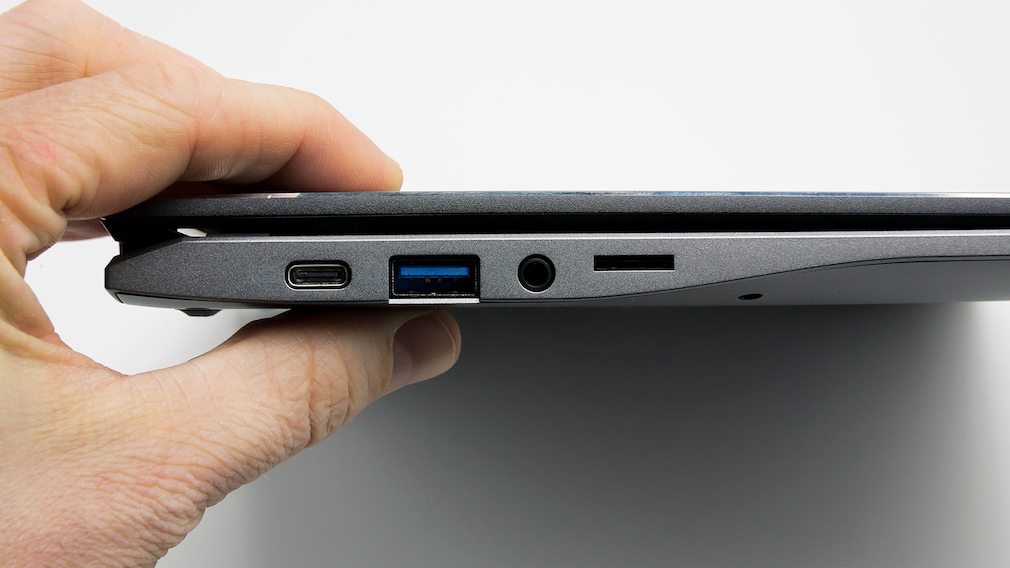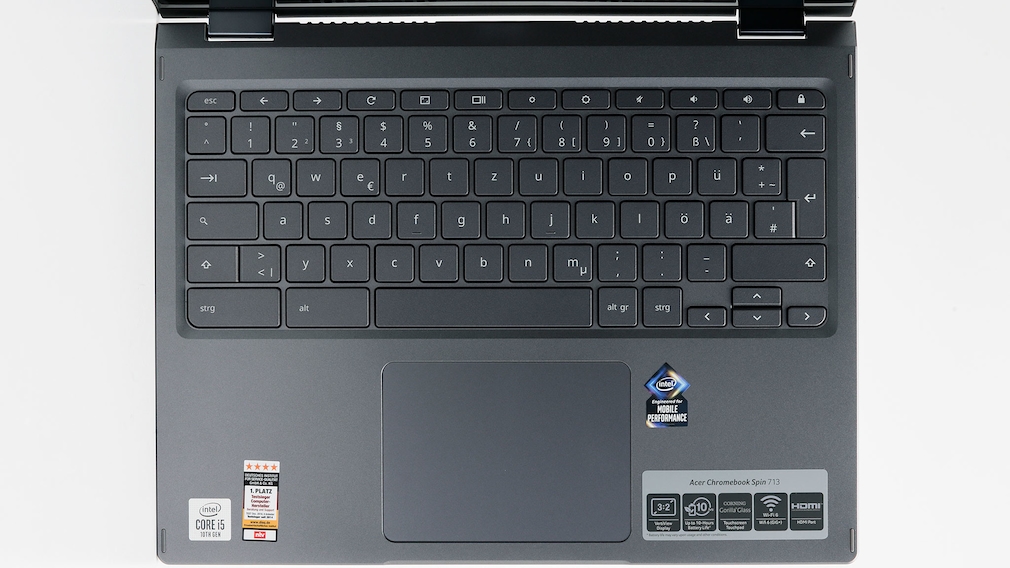The Spin 713 is something of a flagship Chromebook. COMPUTER BILD had already tested a comparable version for a good 800 euros in autumn 2020. It offered a very decent performance for the price. A lot has happened since then. The editors have revised the testing process for Chromebooks, and the Spin 713 has become more affordable. The tested device is available online from 639 euros. And after the first look at the 34-centimeter screen, you want to say: Good deal!
At around 1.4 kilograms, the Chromebook Spin 713 weighs too much to pass as a digital newspaper.
A shiny Chromebook
The display shows beautiful, natural colors and offers a wide viewing angle. Only the contrast reproduction could have been a bit higher. When it comes to the format, the manufacturer takes a special approach. Instead of the traditional 16:9 aspect ratio, the Chromebook comes in a 3:2 format like a Microsoft Surface laptop. The screen offers users more vertical display area – ideal for working with texts and tables. The Acer, on the other hand, is less suitable for enjoying movies, especially since you have to put up with thicker bars in full-screen mode. Too bad about the beautiful colors. At least the brightness is right: 450 candelas per square meter is a decent value for a Chromebook. Content can also be viewed well with a lamp in the back.

On the left are a USB-C and USB-A port (each USB 3.2), a headset jack and a microSD card reader (from left), on the right an HDMI and USB-C port.
The touch screen brings benefits
Many Chromebooks offer a touchscreen. This also makes sense, since no conventional Windows programs run on Chrome OS, but Android apps from the Google Play Store. Although most of them can also be controlled with a mouse and keyboard, they are designed for touch operation. The Acer is exemplary here. It can be operated really well via the screen.
The Chromebook displays content quickly. The Core i5-10210 U from Intel’s “Comet Lake” series from 2019 does that. As I said: You don’t need a cutting-edge processor to work on a Chromebook. The Spin 713 is no exception. Google’s own apps, such as Google Docs and Google Sheets, run best in the browser anyway. If you want to edit an image quickly, you can’t use the full Photoshop, but you can find Photoshop Express or Snapseed as good alternatives in the Play Store. Both apps run smoothly on the Spin 713.

The touchpad turns out to be small. In return, the keyboard offers a good pressure point – and the Chrome OS-typical special keys in the upper row.
It looks different when gambling. A game of billiards or a round of the still nice puzzle game “Monument Valley” can certainly provide a few relaxing minutes. However, as soon as the graphics become a little more complex, the Chromebook starts to stutter. Even if the gamer doesn’t turn up the graphics settings, the games stutter across the screen. That’s not enough for the price!
The memory is expandable
“Little” is also the keyword when it comes to memory. Traditionally, it is rather meager in Chromebooks. The background: users should not save their data locally, but entrust it to the Google cloud services Google Photos and Google One. Accordingly, the Acer does not exactly have a generous 109 gigabytes of memory. Twice as bitter: the manufacturer sometimes installs an SSD, and then it works rather leisurely. After all, users don’t have to pay Google monthly if they don’t have enough space. Instead, the memory can be easily expanded using a microSD card. 128 gigabytes are available from around 14 euros. Online, Google only provides 15 gigabytes for free. An additional 100 gigabytes cost 1.99 euros per month with a Google One subscription.
Finally, a word about the battery life: With more than seven hours, the Acer does not show an outstanding performance here, but it is very solid. That describes its overall quality quite well.
Test conclusion: Acer Chromebook Spin 713
At the time of testing, the Acer Spin 713 was available for a fair 639 euros. On the one hand, it offers a decent speed, high image quality, a long battery life and was always quiet. On the other hand, it has little memory. Anyone who wants to buy it should know what they are getting themselves into. The system is beautifully simple, but also limited in its possibilities. The Chromebook is suitable for users who primarily work with Google services and surf a bit. But if you also want to play current games on it or are dependent on a full version of Photoshop, for example, you should better choose a Windows 11 notebook.
